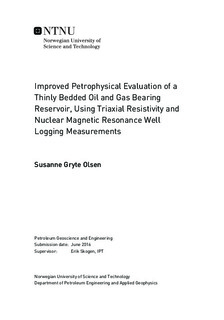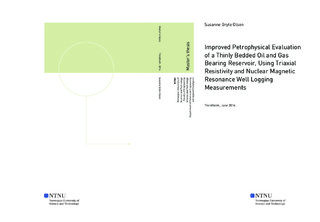| dc.description.abstract | The aim of this thesis was to conduct a petrophysical analysis on a laminated thin bedded reservoir from well 7220/8-1, containing gas in the upper section. A conventional analysis was done in advance, in order to create a basic zonation and an analysis of the logs available. The well was in addition compared with log data from two wells from the same area, 7220/7-1 and 7220/5-1, in order to see similarities and differences and correct for zonation within the two main reservoir formations, Stø and Nordmela.
Due to the conductive shale laminations masking the more resistive, hydrocarbon (HC) filled sand layers in the laminated reservoir sections, a method for calculation of corrected resistivity for the coarse grained layers (Rcg) was carried out. This method applied both NMR T2 distributions as indications for shale and sand fractions, and triaxial resistivities (Shray and Borbas, 2001).
As the reservoir contained gas, a new porosity was carried out in order to correct for both density and NMR porosities, which provided inaccurate values. A method combining both density and NMR porosities into one equation, called the Density Magnetic Resonance (DMR) method was applied to the dataset (Freedman et al., 1998).
In order to do a quality check of the zones interpreted as clean sand, laminated shaly sand, dispersed shaly sand and shales, Thomas-Stieber diagrams were created. DMR and density porosity vs. gamma ray was plotted, and an interpretation of the zonation was performed based on endpoints for clean sand, shale and dispersed shale.
A summary was done as a final result by applying a corrected water saturation, calculated from Rcg and DMR, as input. This resulted in a HC pore thickness for each zone, which was multiplied with the sand volume and summed together as a total thickness for the reservoir.
The Rcg resistivity carried out showed good correlation with the vertical resistivity in the reservoir, and hence an elevated value in the laminated HC zones of the reservoir. This result is considered as more accurate within the coarse grained zones, due to the actual resistivity within the sand laminas being considerably higher than the averaged parallel measurements from the apparent resistivity curve (Rt). The results calculated from the DMR method showed excellent correlation with core porosities within the gas zone and throughout the whole reservoir interval. The DMR porosity equation corrected for both the elevated density porosity and the reduced NMR porosity.
The Thomas-Stieber diagrams provided plots that displayed a distribution of points from the assumed laminated zones around the laminated line, and the clean zones around the endpoints on the plot. No dispersed shale zone was indicated from the plot, and Archie s equation was therefore applied to all zones for saturation and summary calculations. The final summary result provided a total hydrocarbon pore thickness of 22.3 m within the reservoir section of 120.0 m | |

